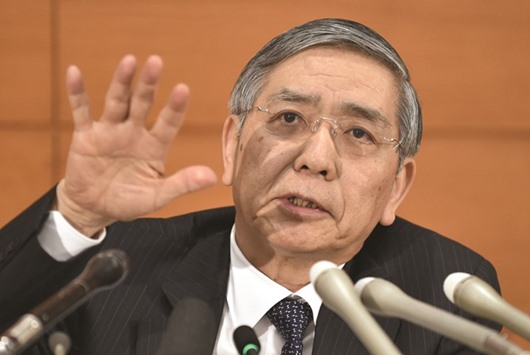Three years since Bank of Japan (BoJ) Governor Haruhiko Kuroda embarked on an unprecedented monetary experiment, yields continue to test new lows even as concern grows that his policies will cripple the world’s second-biggest bond market.
Yields have tumbled below zero on maturities up to a decade following the central bank’s surprise decision this year to implement negative interest rates, after unleashing two rounds of quantitative easing since April 4, 2013.
As the BoJ’s bond holdings have swelled to one-third of total debt outstanding, the market has begun to seize up amid a dearth of liquidity, causing volatility to soar. Even so, inflation - and inflationary expectations - remain far from Kuroda’s 2% target.
That’s why an overwhelming majority of analysts predict the BoJ will expand stimulus again by July, even while some warn that the technical limits to the asset-purchase programme are rapidly approaching. In the BoJ’s latest survey of bond market participants, 41% rated market functioning as “low.” Kuroda said yesterday the central bank can lower the deposit rate from the current minus 0.1% if needed, and he doesn’t think negative rates will make asset purchases difficult.
“The bond market is becoming increasingly exhausted, and increasingly volatile,” said Shuichi Ohsaki, the chief rates strategist at Bank of America Merrill Lynch in Tokyo. “It’s not a properly functioning market anymore. This stimulus can’t go on indefinitely.”
The following five charts track the effect of three years of Kuroda stimulus on the markets:
Even before Kuroda’s stimulus began, the anticipation spurred by Prime Minister Shinzo Abe’s election campaign promise of unlimited monetary easing caused a sharp rally in Japanese stocks and a decline in the yen. But in the summer of 2015, those trends reversed. By contrast, bond yields, after an initial bout of volatility, have pressed ever lower.
The benchmark 10-year yield was minus 0.075% in Tokyo yesterday, after touching a record minus 0.135% on March 18. A sale of 10-year notes yesterday went off at a record-low auction yield of minus 0.069% and drew the strongest demand since August 2014.
The globalisation of markets has meant that BoJ stimulus was felt immediately by sovereign debt markets worldwide, including Treasuries. Barclays Plc is among those saying that massive central bank easing in Japan and Europe is preventing the Federal Reserve from tightening its own monetary policy.
Market participants have expressed concern about liquidity since quantitative easing began, spurring the BoJ to begin a quarterly survey at the start of 2014. February’s poll had the highest proportion of respondents so far describing functioning as “low.” At its January meeting, the central bank forewent an expansion of asset purchases, opting instead for negative rates.
As a result, volatility in the JGB market surged to the highest since 2003 - and continues to climb. The money market is also under stress: overnight lending has frozen, the repo market has flipped on its head, and money market funds have stopped accepting new money.
The strain in the bond market is building even though the central bank’s benchmark gauge for achieving 2% inflation has languished near zero for a year. Market indicators of consumer price expectations have also been in decline, and actually deepened their slump since the announcement of negative rates on January 29.
“These three years have proven that it’s difficult to revive growth and inflation with monetary policy alone,” said Kazuhiko Ogata, chief Japan economist at Credit Agricole in Tokyo. “The BoJ is running out of bullets.”
Business / Business
Japan bond market ‘exhausted’ as central bank chief’s stimulus enters fourth year

Kuroda: Embarking on an unprecedented monetary experiment.
